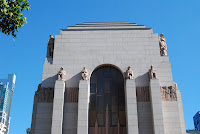I watched a documentary called Garbo: The Spy that was showing durin the Spanish Film Festival.The
documentary was based on the life of Joan Pujol Garcia, who was one of the most
successful double agents
during the World War
II. He was known by the British codename Garbo and the German codename Arabel.
I
didn’t know anything about this man before I saw the documentary, but after
watching it, I was taken back how sophisticated and intelligent one man can be.
At the time when Hitler and the German Army occupied France and were at full
capacity to overtake Britain, Joan Pujol Garcia, wrote history. He played the
key role of Operation Fortitude, which was the deception operation to mislead
the Germans about the timing and location of the invasion of Normandy. The
piece of paper, which was a communication sent to the Nazis by their most
trusted spy in Britain (Juan Pujol Garcia
or Arabel), reveals how the agent gave deceptive information on Allies' D-Day
landing plans in 1944.
 Joan, who was a Spanish businessman and believed by the
Germans as one of their top assets in the UK, however he was actually working
for Britain's intelligence. This
double-cross convinced Hitler that the Allies were about to stage the bulk of
the D-Day landings in Pas de Calais rather than on the Normandy coast. This diversion was crucial in
guaranteeing Britain’s success and ending the rein of Hitler.
Joan, who was a Spanish businessman and believed by the
Germans as one of their top assets in the UK, however he was actually working
for Britain's intelligence. This
double-cross convinced Hitler that the Allies were about to stage the bulk of
the D-Day landings in Pas de Calais rather than on the Normandy coast. This diversion was crucial in
guaranteeing Britain’s success and ending the rein of Hitler.
For
his efforts in aid of the Allies Joan received an MBE
from the British and in an ironic twist of fate, following the war he ended up
encountering one of his German handlers, who gave him the Iron Cross for his contribution
to the German war effort. The Nazis never realized that Joan had fooled them,
and thus he earned the distinction of being one of the few people during World War II to receive
decorations from both sides.


























